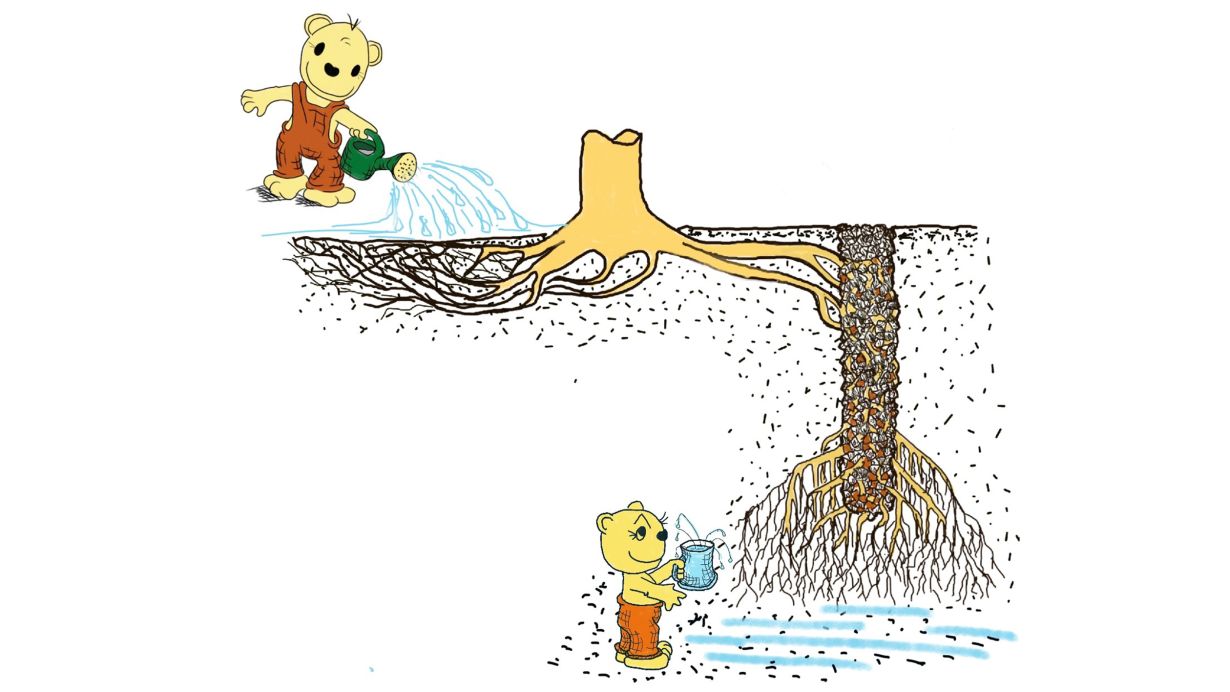Tree roots are drawn towards moist soil, a phenomenon known as hydrotropism. Near surface watering therefore causes roots to stay close to the surface instead of growing deep into the ground. Biomechanical engineers from Karlsruhe Institute of Technology (KIT) developed a new, easily applied method, the “gravel cylinder,” to attract the tree roots towards deeper, moister soil layers. This should make trees more resistant to the consequences of climate change.
City and park trees as well as those on private property increasingly suffer from drought stress because of climate change and the associated reduced rainfall in our region. Plant roots usually grow towards higher soil moisture. “Regular near surface watering draws the roots towards the surface instead of the depth where they would find more moisture,” explains Professor Claus Mattheck from the Biomechanics Group of the KIT Institute for Applied Materials. “This means we have to offer an incentive for the roots to grow deeper.” Modern irrigation methods already make use of vertical tubes to bring water into deeper soil layers, drawing the roots down where the soil does not dry out as easily.
Stone Gravel against Drought
Using KIT’s newly developed gravel cylinder method, trees in cities, parks or home gardens could be prepared for drought with a simple procedure. The basis is a mixture of coarse stone gravel and terra preta, a type of fertile black soil originally coming from the Amazon region. This mixture is inserted into the ground as deep as possible, for example in a 20 to 30 centimeters wide drilled hole.
“We expect the roots of the trees to be drawn towards and grow into this well aerated column of gravel, that is enriched by terra preta and barely compactable by traffic-induced vibrations,” Mattheck explains the goal of the procedure. Experiments with corn plants confirm this hypothesis. Studies on trees are in progress at multiple locations.
The idea to use terra preta as fertilizer came from Siegfried Fink, Professor for Forest Botany at the University of Freiburg, who conducted research in the Amazon.
Deeper soil layers usually contain more moisture, which attracts the roots. “Once the root density at the lower end of the gravel cylinder grows too high, it is expected that the roots will spread out into this deeper soil layer with more moisture. At this point, continuously watering the tree will not be necessary anymore,” says Mattheck. At deeper levels the roots find more water even during a drought.
“For the trees, the gravel cylinder is a sort of feeding ground and root diving station to help them help themselves,” the scientist remarks, content with the new method. “Root penetration of the gravel cylinder takes a while, though. Tree friends have to be patient.” However, soils with high clay content are not suitable for this method, as they could fill up with water and suffocate the roots.
This method has just been published in eBook format and a scientific publication of the main findings has been accepted by the specialist magazine Arboricultural Journal.
Original Publications:
Claus Mattheck, Klaus Bethge, Karlheinz Weber, Iwiza Tesari: “Klimafester Baum? Biomechanische Anpassung der Baumwurzel an den Trockenstress“. On request.
C. Mattheck, S. Fink, K. Bethge, K. Weber, I. Tesari: A Strategy to Help Trees Suffering from a Drought, Arboricultural Journal, in press.
In close partnership with society, KIT develops solutions for urgent challenges – from climate change, energy transition and sustainable use of natural resources to artificial intelligence, sovereignty and an aging population. As The University in the Helmholtz Association, KIT unites scientific excellence from insight to application-driven research under one roof – and is thus in a unique position to drive this transformation. As a University of Excellence, KIT offers its more than 10,000 employees and 22,800 students outstanding opportunities to shape a sustainable and resilient future. KIT – Science for Impact.

